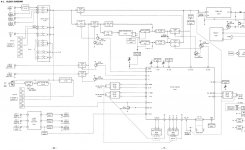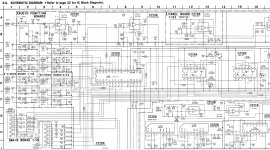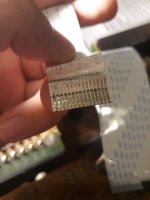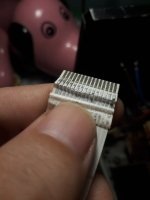Look at this, this is a really nice modern open source DIY project preamp.
preamp-two/images at master * FutureSharks/preamp-two * GitHub
preamp-two/images at master * FutureSharks/preamp-two * GitHub
The issue is that "modern amplifier" is becoming an oxymoron, as component stereos give way to digital entertainment. There is no more "pre-amp" component. Instead you have a sound card and few inputs are analog. The switching may be data, not analog. All recording are digital and only become analog at the output DAC.
Switching analog audio without distortion or pops and thumps is something only a switch and some relays do well. But well designed semiconductor selectors are fine as long as the audiophile owner doesn't know about it. So those few who care will use legacy mechanical switches in their component stereos.
I think the classic one-of-n selector is not the best idea. An individual on-off switch/pot for each input allows mixing multiple inputs.
Switching analog audio without distortion or pops and thumps is something only a switch and some relays do well. But well designed semiconductor selectors are fine as long as the audiophile owner doesn't know about it. So those few who care will use legacy mechanical switches in their component stereos.
I think the classic one-of-n selector is not the best idea. An individual on-off switch/pot for each input allows mixing multiple inputs.
coincidently I was reading/searching about about switches and it lead me to 'channel bleed'. Where in an integrated amplifier signals bleed in to the input selected while the non selected input is live; and volume is turned on. I presume it depends on how the circuit is designed but does this happen because the ground is made common for various input selectors ?
pardon for newbie questions.
pardon for newbie questions.
Bleed can be due to various mechanisms, but capacitive coupling is a common one. This can be reduced/eliminated by only switching low-impedance signals (which are not affected by capacitive coupling). Thus you buffer each input before the selector.
A 47k input impedance is highly susceptible to even < 1pF of coupling (at 20kHz 1pF is 8M,
so a full strength HF signal will couple at about 45dB down to a 47k circuit if there's 1pF of coupling, but 120dB down to an 8 ohm circuit)
Capacitive coupling is principly high frequencies only. Ground loop problems will have a flat frequency response, so easy to distinguish.
Ground coupling is cured by correct layout, but will be worse when an unwanted signal has a low impedance load (higher currents flowing in the ground wiring). Its hard to imagine why a signal that's not selected is dissipating into a load at all though, though a level preset trimmer is a possibility.
Analog switch chips have non-linear resistance, but this need not contribute to distortion at all if used cleverly - switch the signal as a current and the variation in resistance with voltage is completely invisible. More complex circuitry, granted.
A 47k input impedance is highly susceptible to even < 1pF of coupling (at 20kHz 1pF is 8M,
so a full strength HF signal will couple at about 45dB down to a 47k circuit if there's 1pF of coupling, but 120dB down to an 8 ohm circuit)
Capacitive coupling is principly high frequencies only. Ground loop problems will have a flat frequency response, so easy to distinguish.
Ground coupling is cured by correct layout, but will be worse when an unwanted signal has a low impedance load (higher currents flowing in the ground wiring). Its hard to imagine why a signal that's not selected is dissipating into a load at all though, though a level preset trimmer is a possibility.
Analog switch chips have non-linear resistance, but this need not contribute to distortion at all if used cleverly - switch the signal as a current and the variation in resistance with voltage is completely invisible. More complex circuitry, granted.
Last edited:
> it lead me to 'channel bleed'.
Not a big problem in hi-fi. How many sources play continuously?
The record and CD players make sound only when a disk is in/on the player. Same for tape.
PC/iPod/DAC sources can usually be turned-off easily.
The usual offender is a radio tuner. So turn-off the tuner when not listening to the radio.
Not a big problem in hi-fi. How many sources play continuously?
The record and CD players make sound only when a disk is in/on the player. Same for tape.
PC/iPod/DAC sources can usually be turned-off easily.
The usual offender is a radio tuner. So turn-off the tuner when not listening to the radio.
A 47k input impedance is highly susceptible to even < 1pF of coupling (at 20kHz 1pF is 8M, so a full strength HF signal will couple at about 45dB down to a 47k circuit if there's 1pF of coupling, but 120dB down to an 8 ohm circuit)
The signal sources normally have impedances << 47 kohm, so it is only that bad when you listen to an open input.
True, but it doesn't inspire confidence if open inputs suffer break-through - after all we use shielded cables outside the amp, we'd expect equal isolation inside the amp!The signal sources normally have impedances << 47 kohm, so it is only that bad when you listen to an open input.
I have an old integrated amplifier Sony TA-A70.
Suddenly I got the problem with input select switch. Whatever position I switch the switch rotary, all the current input sources are mixed together at the output sound. For example, I have CD Input, Tuner, Video 1 (Audio input) connected but the sound from the speakers is of 3 input. So now I have to unplug 2 input and keep CD Input to listening the music.
My Input select IC is LC7821 (IC102), IC705 MC14051BCP for Position Data Scan for switching between PHONO, TUNER, TAPE, CD, VIDEO1, VIDEO2, VIDEO3, and system control IC701 uPD75106CW-195.
Is this indicate the LC7821 broken? I share the service manual.
Google Drive: Sign-in
I'm newbie and not know where to start to trace the issue. Please help!!!
Suddenly I got the problem with input select switch. Whatever position I switch the switch rotary, all the current input sources are mixed together at the output sound. For example, I have CD Input, Tuner, Video 1 (Audio input) connected but the sound from the speakers is of 3 input. So now I have to unplug 2 input and keep CD Input to listening the music.
My Input select IC is LC7821 (IC102), IC705 MC14051BCP for Position Data Scan for switching between PHONO, TUNER, TAPE, CD, VIDEO1, VIDEO2, VIDEO3, and system control IC701 uPD75106CW-195.
Is this indicate the LC7821 broken? I share the service manual.
Google Drive: Sign-in
I'm newbie and not know where to start to trace the issue. Please help!!!
Attachments
Last edited:
- Status
- This old topic is closed. If you want to reopen this topic, contact a moderator using the "Report Post" button.
- Home
- Amplifiers
- Solid State
- Input selector in modern amplifiers



